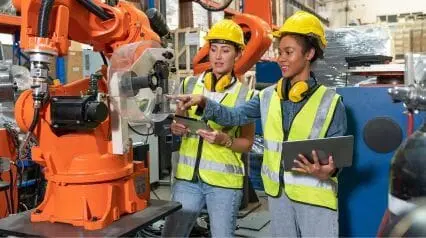What is Industrial IoT?
The Industrial Internet of Things (IIoT) is the application of IoT technologies and principles in the industrial setting. It involves the integration of hardware (e.g., equipment, machinery, and systems) into the cloud or private networks to enable data gathering and exchange, continuous status monitoring, and improved operational decision-making. Ultimately, this interconnected network improves efficiency, boosts productivity, and enhances the safety of the entire industrial process.
Benefits
According to an Oxford Economics survey, companies that have adopted IoT in their operations increased their productivity, gained more profits, and fared better during crises, as evidenced by the most recent economic downturn caused by the pandemic. Now, companies across industries are expressing their interest in this technology. Here are some of the benefits of industrial IoT:
- Promotes a proactive approach – Anticipating the needs and challenges in any work setting is crucial to the success of organizations. Industrial predictive maintenance with IoT does not just inform the need for repairs or replacement. It also reduces the need for premature or unnecessary machine servicing, which saves company resources.
- Improves efficiency, quality, and safety – The technology enables companies to monitor their workflows in real time, facilitating better decision-making in emergencies, reducing delays and downtimes, and improving productivity. Companies also get to optimize their resource utilization, leading to significant cost savings.
The continuous and targeted monitoring of the process through industrial IoT sensors helps detect defects and deviations. Maintaining or enhancing quality with IIoT minimizes the possibility of recalls, thereby increasing customer satisfaction and trust.
Monitoring also aids in ensuring workplace safety. Numerous devices in the IIoT ecosystem prevent work-related injuries, from measuring air pollution and noise levels to identifying malfunctioning machines that workers should temporarily steer clear of.
- Enhances compliance and sustainability efforts – Aside from providing companies with a bird’s eye view of the operations, the system also generates reports. With IIoT, companies can collect, analyze, and store data more efficiently. The resulting documents can be reviewed by management to ensure they meet their sustainability goals or sent to regulatory offices as proof of their adherence to mandates and industry standards.
Explore SafetyCulture Monitoring Solution
Utilize advanced sensor technology to monitor assets, automate vital alerts, implement actions, and report urgent issues.
Talk to an expertIIoT Across Sectors
With its ability to connect machines and systems, the industrial IoT platform drives innovation and efficiency. It may be hard to imagine what components of the industrial IoT platform a particular business will need or how they can positively impact the operations, so read on to see the various IoT industrial applications.
Manufacturing
IIoT positively impacts the manufacturing sector by streamlining operations, decreasing downtime, and improving product quality. Numerous pioneers like Bosch and General Electric (GE), with their “Brilliant Manufacturing” initiative, have greatly benefited from IIoT with reduced defects and, subsequently, costs.
Use Cases:
- Predictive Maintenance – Manufacturers monitor the performance of their machines and predict equipment failures before they occur, reducing unplanned downtimes and delays.
- Quality Control – Analyzing sensor data in real-time helps workers detect defects, which ensures product quality.
- Inventory Management – Efficiently racking raw products, tools, and manufactured outputs is possible through RFID and sensor technology.
Energy and Utilities
Automation drives energy efficiency. With IIoT, companies can better respond to consumer needs and, more importantly, critical situations that threaten their operations, as it improves resource management, boosts grid efficiency, and assures dependable power distribution.
Use Cases:
- Smart Grids – Supervising energy transport from generation sources to end users is less complicated with IIoT sensors. Aside from waste reduction, the technology also improves the reliability of the distribution.
- Environmental Monitoring – By tracking air, water, and soil quality, companies stand firm in their conservation efforts, particularly in controlling pollution.
- Compliance Tracking – Because the sector’s impact on the environment and the lives of its consumers is immense, energy and utility companies are highly regulated. With IIoT, companies can keep track of their compliance responsibilities competently.
Agriculture
Drones, computer imaging, and remote sensors enhance several workflows in the industry, from crop management to sustainability efforts. Not only does this increase productivity and ensure conservation, but the technology also improves the safety and well-being of farm workers and the community they belong to.
Use Cases:
- Precision Agriculture: Sensors provide real-time data on weather conditions and soil moisture, helping farmers to manage their resources better.
- Livestock Monitoring: IIoT devices like wearable tags can track the location and health of livestock, informing ranchers of impending births or diseases.
- Efficient Daily Workflows: Aerial drones replace labor-intensive tasks, like dropping seeds on the soil, spraying pesticides, and conducting crop testing. Track-and-trace technology also monitors the operations from harvest to delivery.
Transportation and Logistics
Precision and real-time visibility are crucial to this sector, as these improve delivery times, reduce operational costs, and enhance the safety of individuals directly engaged in the system. United Parcel Service (UPS) and Maersk have embraced IIot and gained from its benefits. Here are some specific industrial IoT examples in this industry:
Use Cases:
- Telematics for Fleet Management – With IIoT, companies can track their vehicles in real-time, optimize routes, become more proactive in asset maintenance, and optimize fuel consumption.
- Cold Chain Monitoring – Temperature-sensitive goods, like food and medications, are safely stored and transported globally by installing sensors on refrigerated warehouses and trucks.
- Track and Trace – RFID (radiofrequency identification) and AIDC (automatic identification and data capture) help ensure that goods get loaded into the appropriate vehicles, stored in the proper warehouse, and delivered to the right client.
Healthcare
The Internet of Medical Things, or IoMT, is one of the fastest-growing segments in the IoT market, with the potential to reach $176 billion in 2026. This is not hard to understand why: it streamlines hospital operations, improves medical research, and most importantly, enhances patient care.
Use Cases:
- Remote Patient Monitoring – Wearable devices collect vital signs like heart rate, temperature, and blood pressure, eliminating the need for nurses to wake their patients at odd hours or for patients to travel to the nearest hospital to have it taken.
- Medical Equipment Monitoring – Sensors track the condition and performance of various hospital and laboratory equipment, informing administrators about the need for maintenance, calibration, repair, or replacement.
- Robotic surgery – Complex procedures do not require large incisions or hours on the operating table with small and reliable devices that can be inserted into the body, aiding doctors in accomplishing their procedure safely, successfully, and with minimal disruptions.
Smart Cities and Infrastructure
Environmental conservation is on everyone’s consciousness with the real threat of climate change. IIoT helps as it converts cities into smart, sustainable, and efficient urban centers, optimizing resource utilization, enhancing safety, and improving services for the citizens.
Use Cases:
- Traffic Management – Cameras and sensors are installed in cities like Los Angeles, London, and Singapore to monitor traffic flow, reduce congestion, and enhance road safety.
- Waste Management – Traditional modes of garbage collection and disposal increase carbon footprint. IoT optimizes waste collection routes, minimizes emissions from incinerators, and limits chemical contamination in water and soil.
- Water and Utility Management – The technology also improves operations by monitoring water distribution and boosting energy infrastructures for resiliency and reliability.
Ensure Quality and Safety with Cutting-Edge Sensor Solutions
Empower your business to prioritize safety and operational excellence with SafetyCulture’s sensors. This monitoring system from the top-rated inspection platform offers a versatile solution spanning various sectors, from logistics providers who want to safeguard perishable goods during transit to healthcare providers who aim to provide the best care by providing well-stored medications.




